Research Article | DOI: https://doi.org/DSOMI-RA-24-008
Regenerative Endodontic Treatment: A Bibliometric Analysis of Global Indian Author’s Research Contribution during 2000 to 2023
Abstract
Background: Regenerative endodontic (RE) treatment is a new paradigm shift in the management of non-vital or necrotic immature young permanent teeth and has substantiated with numerous research publications in the endodontic literature.
Methods: A bibliographic database search was performed using PUBMED and Google Scholar for the published articles from 2000 to March 2024. All articles published in English language only in this period were selected constituting only Indian authors who are working within India, their affiliations, working specialty, Indian institutions//College/University, gender, state of origin of the published article and journal name with its impactor factor. The obtained data was tabulated and analysed for the estimation of bibliometric details.
Results: The estimated Indian authors contribution towards RE on global level was 3.34% with maximum original studies (N=11). Saveetha Dental College was found with highest publication (N=4). International Journal of Clinical Pediatric Dentistry (N=4) conquered the first place with maximum publications followed by Cureus (N=3). Karnataka state (N=7) and south zone (N=20) were found with maximum research output. Conservative Dentistry (N=17) and Pediatric and Preventive Dentistry specialty (N=11) crowned with highest research publications towards RE.
Conclusion: The present bibliometric analysis showed that although there is growing interest and trend among Indian researchers/authors in utilisation of RE, however there is insufficient evidence-based results pertaining to this domain.
Introduction:
Children present with frequent injuries to their anterior teeth resulting in pulpal damage and necrosis which requires a serious attention as anterior teeth play a major role in speech, esthetics and function. The young permanent anterior teeth exhibit wide open blunder buss apex and thin lateral dentinal walls requiring a modifying treatment approach. [1] Although various conventional and recent restorative materials have shown successful outcome in the management of these teeth, each one are associated with their own drawbacks. As a result, a revolutionary biologic technique has touched the doors of endodontic field and resulted in a tremendous paradigm shift.[2] This novel modality includes “regenerative endodontic procedures” and developed with the concept of stimulation of stem cells present in the apical region of the tooth in order to release growth factors which in turn combined with an appropriate physical scaffold will lead to regeneration of pulp tissue inside the root. [3] Various research studies have been undertaken across the globe within this context to show efficacy of various scaffolds such as blood clot, collagen, platelet-rich-plasma and plate-rich fibrin in the pulp regeneration. [1-10] India, being part of Asia represents the second most highly populated country in the world and hence it is essential to evaluate the available research evidence related to dental health science.
Krishnan et al in 2020 [11] analysed the research contribution of Indian authors about regenerative endodontic procedures by evaluating all publications published during the period from 2008 to 2019. As there was a sudden onset of COVID pandemic, there was tremendous changes happened in the research activities in many parts of the world including India. [11] Therefore, it is highly essential to study the scenario of the Indian authors/researcher’s contribution after post covid period towards dental health science including regenerative endodontic treatment. Hence the present retrospective observational study was carried out to answer for the research question of the present bibliometric analysis “what is the overall Indian authors’ contribution towards regenerative endodontic treatment in global level?” so that using the results of obtained evidence, further therapeutic guidelines or recommendations can be put forward Infront of the scientific society.
Materials and methods
Retrieval of publications from the period 2000 to March 2024 pertaining to only Indian based articles was performed using two electronic databases PubMed and Google Scholar.
Inclusion criteria
All type of publications which are in English language and including original studies, case series, systematic reviews and meta-analysis, narrative literature reviews and case reports were considered for this bibliometric analysis. Among these publications, articles belonging to only first author of Indian origin and affiliated or working in Indian institutions/organisations/ colleges were included.
Exclusion criteria
Articles consisting of Indian authors but their affiliation related to outside of India, and articles showing only abstracts and repeated publications in multiple journals were excluded from this analysis.
Study protocol
Electronic database search using PubMed and google scholar was carried out for a period of one month for the selection of articles published from 2000 to March 2024. Different medical MeSh search keywords like regenerative endodontic procedures, treatment of immature or necrotic permanent teeth, management of young permanent teeth, traumatized immature teeth treatment, biological scaffolds, blood clot, platelet-rich-plasma and plate-rich-fibrin or stem cells were used in different combinations for selection of particular articles. All varieties of articles published in various journals irrespective of dental specialty were considered. Based on inclusion criteria selected articles were read in detail to obtain the required data. The selected articles were tabulated encompassing important details like the name of the first author along with gender, year of publication, journal name in which article is published, its impact factor, type of the article, college/university/institution/research centre to which author is attached, specialty and the state of the nation where article published. States were categorized according the different zones of the nation like West, East, North and South zones.
Results
PubMed and google scholar data base search resulted with a total of 3580 articles. From these articles, based on inclusion and exclusion criteria the irrelevant and duplicate articles were removed. Finaly only 33 articles were selected for evaluation to obtain bibliometric details which included original studies, case series, systematic reviews and meta-analysis, narrative reviews and case reports. These articles were arranged in descending order from new to old according to the custom-made table format constituting all details (Table 1).
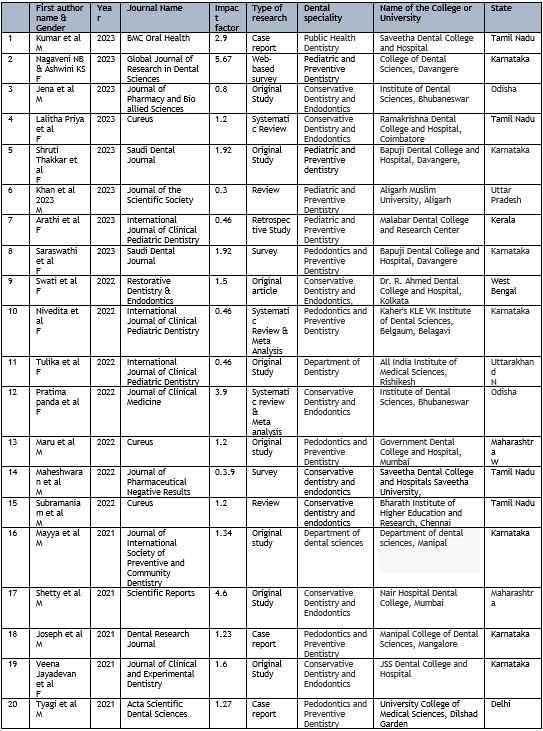
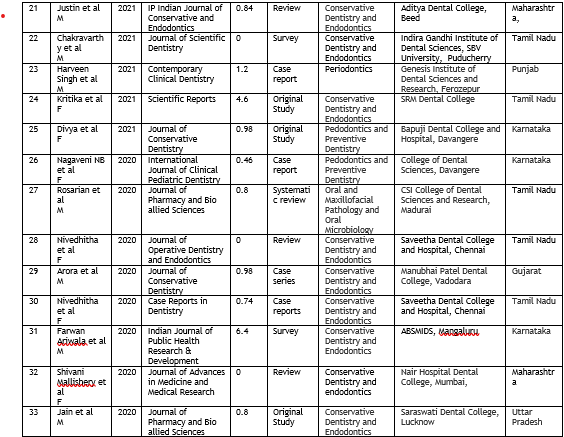
Bibliometric analysis
Indian author’s global contribution
The estimated Indian author’s research output (contribution) pertaining to the domain RE among global PubMed indexed and google scholar cited publications during the period 2000 to March 2024 was about 3.34% (33 publications) (Figure 1).
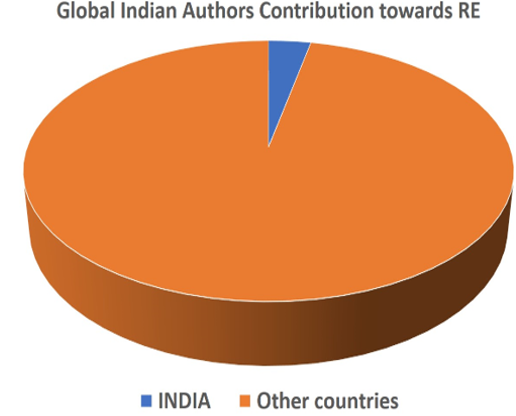
Bibliometric Indian Authors analysis
Analysis of Indian authors who contributed to global scientific literature towards RE consisted total 154 researchers, in that 32 authors were contributed as first authors. The maximum number of authors noted in some publications was 10. Maximum publications of more than one and in first author place was contributed by author like Nagaveni NB (two publications). Authors with more than one publication either in second, third, fourth or fifth place was contributed by authors like Saraswathi Naik (4 publications), Attiguppe Prabhakar (2 publications) and Arathi Prakash (2 publications). Remaining authors contributed single publications. Publications contributed by only two authors was seen in three articles. Articles consisting of only single author contribution was not seen in this bibliometric analysis (Table 2). When gender contribution was analysed with respect to first author, it was noticed that maximum contribution was noted in male researchers (N=18) compared to female authors (N=15).
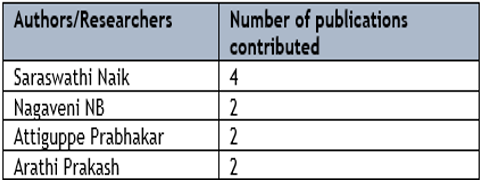
Publication year analysis
When publication year metrics was analysed, it was found that maximum publications were noticed in 2021 (N=10) followed by 8 publications in the year 2020 (N=8) and 2023 and in 2022 with 7 publications (N=7) (Figure 2).
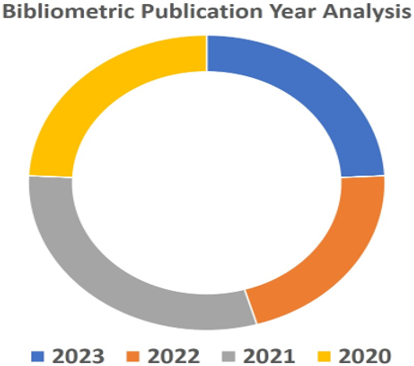
Bibliometric Journal analysis
Bibliometric evaluation of scientific journals showed contribution of maximum publications in the International Journal of Clinical Pediatric Dentistry (N=4) with impact factor 0.46 followed by Journal of Pharmacy and Bioallied Sciences (N=3), Cureaus (N=3), Saudi Dental Journal and Journal of Conservative Dentistry (N=2). Remaining journals contributed single publications each (Table 3).
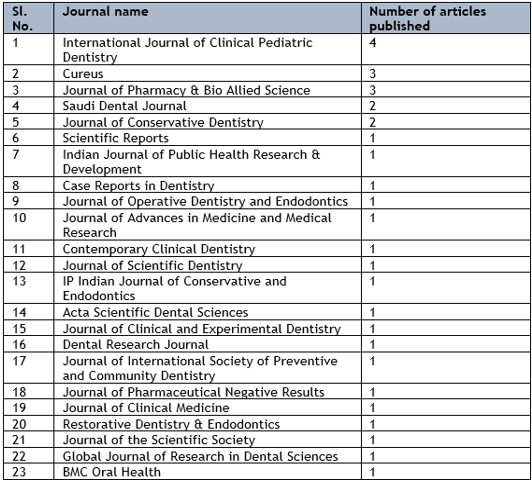
Research Article type analysis
Estimation of bibliometric published research article type analysis revealed maximum of original research articles (N=11), followed by Case reports (N=6), review articles (N=5), questionnaire surveys (N=5) and systematic reviews and meta-analysis (N=4). Other type of articles observed in this analysis were case series articles (N=1) and retrospective study (N=1) (Figure 3).
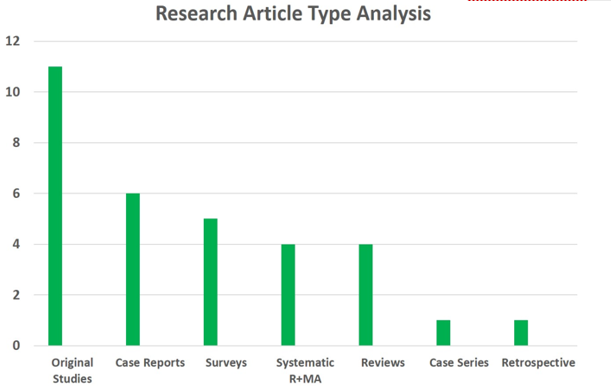
Institution/Research centre/College analysis
Institution analysis found a total of 24 colleges across India which contributed towards research on RE. Among these institutions, Savitha Dental College and Hospital bagged first place in maximum contribution (N=4) followed by Bapuji Dental College and Hospital (N=3), College of Dental Sciences (N=2), Nair Dental College and Hospital (N=2) and Institute of Dental Sciences (N=2) (Figure 5).
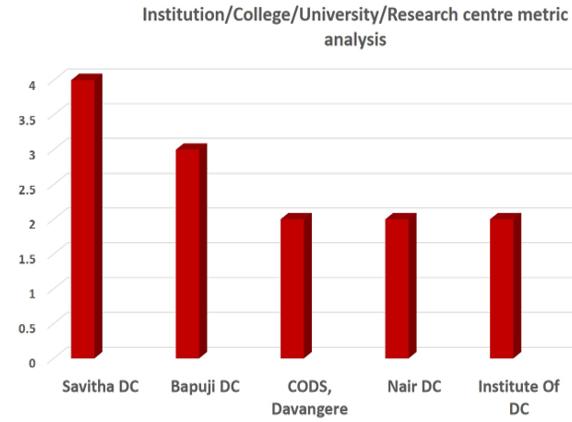
Analysis of State contribution
A total 9 states from India showed research contribution pertaining to RE on global level. In these nine states, the credit of maximum research output goes to Karnataka state (N=10) having numerous high-quality institutions and are active in research publications. The second place was captured by Tamil Nadu (N=9) followed by Maharashtra (N=4). Other states like Odisha and Uttar Pradesh contributed two publications each (N=2). Remaining states like Kerala, Uttara Khand, West Bengal, Gujarat, Punjab and Delhi contributed single publications each (Table 4).
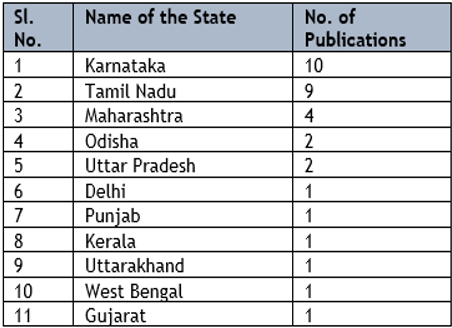
Indian Zonal distribution of research publications
Evaluation of zonal distribution of research articles across five zones of India reflected higher contribution from South zone (N=20). Other zones like North zone contributed 5 publications (N=5), West zone five publications (N=5) and East zone contributed 3 publications (N= 5) (Figure 6).
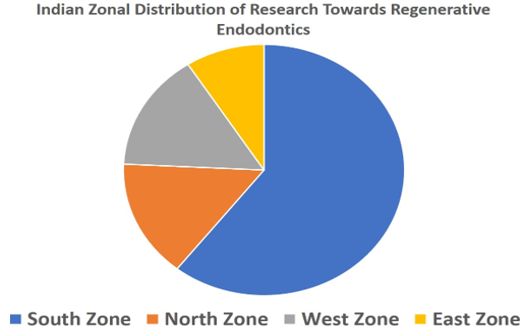
Discussion
Regenerative endodontic treatment is quite a challenging technique in the management of necrotic immature young permanent teeth in children. Various research studies including histological and animal studies have been performed by different investigators across the globe. [12-34] Moreover, it is joyful mater that the American association of endodontists has started funding to research activities to encourage, enlighten and support more research in the arena of Regenerative Endodontics. [11] The present bibliometric analysis and observational study was carried out by evaluating the retrospective electronic data pertaining to regenerative endodontic treatment for the management of non-vital permanent teeth with open apex. The birth of bibliometric analysis resulted in estimation of nation-based evidence in different health related domains across the globe. [11]
The results obtained from the previous bibliometric analysis revealed 7.6% of Indian contribution among the total PubMed indexed global publications on RE and the clinical trials reported from the nation constituted a substantial 22% of the total global output. [11] This bibliometric analysis was estimated to evaluate the research contribution found during the period from 2008 to 2019. In the present bibliometric analysis, which calculated during the total research output during the period from 2020 to March 2024 and revealed 3.34% of Indian authors contribution on the global level (total PubMed and google scholar indexed research output) towards RE. Such national level assessment of total research output regarding any particular health related domain is highly warranted to compare with other nation to assess the current status of the nation’s research. Maximum publication output was noticed in the year 2021 followed by 2022 and 2023. Author metric analysis revealed maximum contribution in first author position by Nagaveni NB from College of Dental Sciences, Davangere, Karnataka. [3,14] With respect to second or third order position, maximum publication was seen with Saraswathi Naik from Bapuji Dental College, Davangere, Karnataka followed by Atttiguppe Prabhakar and Arathi Prakash from the same institution. [13,17,33,34] In previous analysis performed by Krishnan et al, [11] Nagaveni NB and her institution (College of Dental Sciences) stood in the second place. But Saraswathi et al, Prabhakar and Arathi were not in the list of previous analysis. This shows existence of increased awareness, interest in learning and practice of utilising the RE procedures among budding clinicians.
Bibliometric analysis with respect to journal contribution depicted maximum publications published by international journal of Clinical Pediatric dentistry with an impact factor of 0.46 and is associated with an Indian based publishing agency. [13,14,19] The second journal with maximum contribution was shared by Cureus [22,27] which is an international journal with an impact factor of 1.2 and journal of Pharmacy and Bioallied Sciences (impact factor of 0.8). More than one publication was contributed by Saudi Dental Journal (Impact factor 1.92) and Journal of Conservative Dentistry (Impact factor 0.98) (N=2). [17, 33, 34] Remaining journals contributed single publications each. With regard to research article type metric analysis, maximum research was associated with original research studies (N=11) followed by case reports (N=6) and surveys (N=5). Four systematic reviews with meta-analysis were found within this short-stipulated time evaluation (from 2000 to 2023). Among original studies two classical outstanding studies were performed in 2021 by two institutions such as Bapuji dental College, Karnataka and Nair dental college and hospital, Mumbai. [5,34] One study evaluated the 3-dimensional volume space of pulp following regenerative endodontic treatment. [5] In another study for disinfection of the root canal space, an innovative disinfection method using laser was used. [34] This indicates increased trend and interest in performing this novel treatment modality seen among young budding clinicians or researchers. Some case reports showed use of a novel scaffold materials like hydrogel and amniotic membrane which were not used so far. [18,20] Therefore, further prospective studies with more sample size including newer scaffold materials in comparison with other scaffolds is essential to explore more regenerative potential of periapical stem cells.
Evaluation of specialty metric analysis showed maximum research work contributed by department of Conservative Dentistry and Endodontics followed by Pediatric and Preventive dentistry. [3,14,33,34] The reason behind this scenario is associated with the type of patients indicated for or requiring regenerative endodontic treatment is dealt by these two specialties. Other specialties which contributed a single publication was found with periodontics, public health dentistry, oral and maxillofacial pathology departments. Although these specialties don’t perform RE, but for publication purpose must have drafted the manuscript and published the article. Institution metric analysis revealed highest research contribution by Saveeha dental college and hospital situated in Chennai (Tamil Nadu) followed by Bapuji dental college and hospital, Davangere, College of Dental sciences, Davangere both are located in Karnataka state (south zone). [3,14,33,34] Other colleges which showed some amount of research work was by Nair dental college and hospital, Mumbai and Institute of Dental Sciences, Bhuvaneshwar (Odisha state). Saveetha dental college and hospital is at the top of the pinnacle in research work ranked in No. 1 position in NIRF (National Institutional Ranking Framework) ranking. The other institution, College of Dental sciences, Davangere is ranked with A+ grade in NAAC (National Assessment and Accreditation Council) accreditation. Evaluation of state metric contribution exhibited maximum contribution by Karnataka state (N=10) followed by Tamil Nadu (N=9), Maharashtra (N=4), Uttar Pradesh (N=2) and Odisha (N=2). Although institutional analysis showed Saveetha dental college credited with maximum research output, but as Karnataka state contains numerous institutions, the first place with highest publications was associated with Karnataka state.
Analysis of zonal contribution across India from Indian authors about RE was showed that, maximum contribution was performed from Southern zone (N=20). Whereas North zone and West zone contributed five publications. In southern part of India numerous quality institutions/colleges/universities/research centres are located with increased research-oriented aims and objectives. For instance, Saveetha dental college, college of dental science and Nair hospital, AB Shetty dental college and hospital and many more. Among these Savitha dental college is the top most institution almost equivalent to IIT engineering colleges in the research-oriented goals. In addition to this, in south zone availability of research resource, funding, research grants, international collaborative research work is tremendous in these institutions compared to north or other zones of India. The similar observation was found in the previous analysis too.
Conclusion
From this bibliometric analysis it was evident that identification of national level health resources, sectors, high quality research strategies are highly essential to further explore the domain of RE with ample clinical and laboratory-based research evidence for further contribution to the global scientific literature. Therefore, this observational study on bibliometric analysis shows new path for other researchers in the near future to develop more international collaborations and identification of some more active research groups within India.
References
-
Markandey S, Das Adhikari H. Evaluation of blood clot, platelet-rich plasma, and platelet-rich fibrin-mediated regenerative endodontic procedures in teeth with periapical pathology: a CBCT study. Restor Dent Endod. 2022 Oct 21;47(4):e41.
View at Publisher | View at Google Scholar -
Arora A, Bhesania D, Kapoor S, Kaur H. A 5 years' follow-up of root anatomy-based maturogenesis achieved in infected immature molars using regenerative techniques - A case series. J Conserv Dent. 2020 Jul-Aug;23(4):422-427.
View at Publisher | View at Google Scholar -
Nagaveni NB, Ashwini KS, Chiranjeevi H. Knowledge, attitude and perception of dental practitioners about pulp revascularization or regenerative endodontic procedures in children – A web-based questionnaire survey. 2024; 26-35.
View at Publisher | View at Google Scholar -
Panda P, Mishra L, Govind S, Panda S, Lapinska B. Clinical Outcome and Comparison of Regenerative and Apexification Intervention in Young Immature Necrotic Teeth-A Systematic Review and Meta-Analysis. J Clin Med. 2022 Jul 5;11(13):3909.
View at Publisher | View at Google Scholar -
Shetty H, Shetty S, Kakade A, Shetty A, Karobari MI, Pawar AM, Marya A, Heboyan A, Venugopal A, Nguyen TH, Rokaya D. Three-dimensional semi-automated volumetric assessment of the pulp space of teeth following regenerative dental procedures. Sci Rep. 2021 Nov 9;11(1):21914.
View at Publisher | View at Google Scholar -
Jayadevan V, Gehlot PM, Manjunath V, Madhunapantula SV, Lakshmikanth JS. A comparative evaluation of Advanced Platelet-Rich Fibrin (A-PRF) and Platelet-Rich Fibrin (PRF) as a Scaffold in Regenerative Endodontic Treatment of Traumatized Immature Non-vital permanent anterior teeth: A Prospective clinical study. J Clin Exp Dent. 2021 May 1;13(5): e463-e472.
View at Publisher | View at Google Scholar -
Kritika S, Sujatha V, Srinivasan N, Renganathan SK, Mahalaxmi S. Prospective cohort study of regenerative potential of non-vital immature permanent maxillary central incisors using platelet rich fibrin scaffold. Sci Rep. 2021 Jul 1;11(1):13679.
View at Publisher | View at Google Scholar -
Nivedhitha MS, Jacob B, Ranganath A. Concentrated Growth Factor: A Novel Platelet Concentrate for Revascularization of Immature Permanent Teeth-A Report of Two Cases. Case Rep Dent. 2020 Aug 15;2020:1329145.
View at Publisher | View at Google Scholar -
Jain G, Goel A, Rajkumar B, Bedi RS, Bharti D, Sawardeker A. Evaluation of Effectiveness of Intracanal Medicaments on Viability of Stem Cells of Apical Papilla. J Pharm Bioallied Sci. 2020 Aug;12(Suppl 1): S228-S232.
View at Publisher | View at Google Scholar -
Kumar JK, Surendranath P, Eswaramoorthy R. Regeneration of immature incisor using platelet rich fibrin: report of a novel clinical application. BMC Oral Health. 2023 Feb 2;23(1):69.
View at Publisher | View at Google Scholar -
Jena D, Sabiha PB, Kumar NS, Ahmed SS, Bhagat P, Singh SP, Mustafa M. Regenerative Therapy for the Permanent Immature Teeth: A Long-term Study. An Original Research. J Pharm Bioallied Sci. 2023 Jul;15(Suppl 1): S127-S131.
View at Publisher | View at Google Scholar -
Krishnana A, Saini A, Sharma S, Kumar V, Chawla A, Logani A. India’s contribution to regenerative endodontics: A bibliometric analysis. J Conserv Dent 2020; 23(4): 325-329.
View at Publisher | View at Google Scholar -
Prakash AJ, Naik SV, Attiguppe P. Comparative Evaluation of the Regenerative Potential of Blood Clot and Platelet-rich Fibrin in Young Permanent Teeth Based on the Revised American Academy of Endodontics Clinical Considerations for Regenerative Procedure: 2016. Int J Clin Pediatr Dent. 2023 Sep;16(Suppl 2):149-154.
View at Publisher | View at Google Scholar -
Nagaveni NB, Poornima P, Mathew MG, Soni AJ, Khan MM. A Comparative Evaluation of Revascularization Done in Traumatized Immature, Necrotic Anterior Teeth with and without Platelet-rich Fibrin: A Case Report. Int J Clin Pediatr Dent. 2020 Jan-Feb;13(1):98-102.
View at Publisher | View at Google Scholar -
Saxena N, Hugar SM, Soneta SP, Joshi RS, Dialani PK, Gokhale N. Evaluation of the Treatment Protocols in the Management of Pulpally Involved Young Permanent Teeth in Children: A Systematic Review and Meta-analysis. Int J Clin Pediatr Dent. 2022;15(Suppl 1): S103-S113.
View at Publisher | View at Google Scholar -
Priya B L, Singh N, Mangalam KK, Sachdev R, P A, Jain HN, Nagi PK. Success and Complication Rates of Revascularization Procedures for Immature Necrotic Teeth: A Systematic Review. Cureus. 2023 Dec 30;15(12): e51364.
View at Publisher | View at Google Scholar -
Thakkar S, Naik S, Nadig B, Bellal S, Thaliyil A. A comparative clinico-radiographic analysis of regenerative endodontic procedure on immature necrotic permanent teeth using blood clot and PRF as scaffold: A retrospective study. Saudi Dent J. 2023 Sep;35(6):753-759.
View at Publisher | View at Google Scholar -
Singh H, Rathee K, Kaur A, Miglani N. Pulp Regeneration in an Immature Maxillary Central Incisor Using Hyaluronic Acid Hydrogel. Contemp Clin Dent. 2021 Jan-Mar;12(1):94-98.
View at Publisher | View at Google Scholar -
Wakhloo T, Shukla S, Chug A, Dhar M. Advanced Platelet-rich Fibrin-mediated Regeneration of Necrotic Immature Permanent Teeth: A Clinico-radiographic Observational Study. Int J Clin Pediatr Dent. 2022 Jul-Aug;15(4):402-406.
View at Publisher | View at Google Scholar -
Joseph EJ, Karuna MY, Rao A, Rao A, Nayak AP. A novel regenerative endodontic procedure in a traumatized immature tooth using amniotic membrane. Dent Res J (Isfahan). 2021 Apr 6;18:28.
View at Publisher | View at Google Scholar -
Rosaian AS, Rao GN, Mohan SP, Vijayarajan M, Prabhakaran RC, Sherwood A. Regenerative Capacity of Dental Pulp Stem Cells: A Systematic Review. J Pharm Bioallied Sci. 2020 Aug;12(Suppl 1): S27-S36.
View at Publisher | View at Google Scholar -
Maru V, Kb A, Madkaikar M, Devi RS, Gada A, Bapat S. Assessment of the Influence of Various Concentrations of Sodium Hypochlorite on Stem Cell Derived from Human Exfoliated Deciduous Teeth (SHED) Proliferation and Differentiation. Cureaus. 2022 Dec 27;14(12): e33024.
View at Publisher | View at Google Scholar -
Tyagi R, Kalra N, Khatri A, Sabherwal P, Kulood K, Yangdol P. “Regenerative Endodontic Procedure as a Retreatment Alternative for Permanent Maxillary Central Incisors with Aesthetic Smile Correction
View at Publisher | View at Google Scholar -
Kamran KM, Kumar JM. Newer Prospects of Regenerative Endodontics: A Comprehensive and Updated Review of Literature. Journal of the Scientific Society 2023; 50(3): 299-306.
View at Publisher | View at Google Scholar -
Ariwala F, Yelapure M, Hegde MN, Devadiga D, Upasana. Regenerative Endodontics-The Future? A Questionnaire Based Study. Indian Journal of Public Health Research & Development, 2020; 11(1): 363-368.
View at Publisher | View at Google Scholar -
Mallishery S, Shah T. Regenerative Endodontics – Looking Inward. Journal of Advances in Medicine and Medical Research, 2020; 32(7), 83–98.
View at Publisher | View at Google Scholar -
Subramaniam Ramachandran V, Radhakrishnana M, Balaraman Ravindran M, et al. Functionalized nanoparticles: A paradigm shift in regenerative endodontic procedures. Cureus, 2022; 14(2): e32678.
View at Publisher | View at Google Scholar -
Justin MR, Patil PN, Sarda AS, Darade LD, Zanjad SR, Bowlekar R. Review on regenerative endodontics: Past concepts, current protocols and future strategies. IP Indian J Conserv Endod 2021;6(4):205-211.
View at Publisher | View at Google Scholar -
Chakravarthy D, Selvapandiane V, Radhakrishnan SN, Arumugam B, Shivakumar M. Knowledge and Attitude Levels on Regenerative Endodontic Procedures among the Dental Residents in and around Puducherry. J Sci Den 2021;11(2):44–47.
View at Publisher | View at Google Scholar -
Nivedhitha MS, Deepak S, Jacob B, et al. Scaffolds in Regenerative Endodontics: A Review. J Oper Dent Endod 2020;5(2):88–98.
View at Publisher | View at Google Scholar -
Maheshwaran B, Ramesh S. Knowledge Awareness and Perception on Regenerative Endodontics among General Dentists and Specialists. Journal of Pharmaceutical Negative Results. 2022; 13(2): 23-25.
View at Publisher | View at Google Scholar -
Mayya A, Naik R, Paul M, Amin S, Mayya S. Knowledge, attitude and perception among endodontists toward regenerative endodontics: A cross-sectional perception among endodontists toward regenerative endodontics: A cross-sectional survey of four Indian universities. J Inter Soc Prevent Commun Dent, 2021. 11(1): 68-76.
View at Publisher | View at Google Scholar -
Naik SV, Prakash AJ, Prabhakar Attiguppe R. A survey on awareness and knowledge among dentist practicing regenerative endodontics towards current regenerative endodontic protocols and the scaffolds used in regenerative dentistry. Saudi Dent J. 2023 Jul;35(5):559-566.
View at Publisher | View at Google Scholar -
Divya D, Naik SV, Raju OS, Shivani B, Basappa N, Betur AP. Conceptual combination of disinfection in regenerative endodontics: Conventional versus laser-assisted disinfection. J Conserve Dent. 2021 May-Jun;24(3):252-259.
View at Publisher | View at Google Scholar






